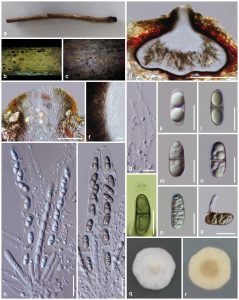Amphisphaeria flava Samarak. & K.D. Hyde, in Samarakoon, Liu, Hyde & Promputtha, Phytotaxa 391(3): 210 (2019)
Index Fungorum number: IF 555396, Facesoffungi number: FoF 04976
Etymology – From the Latin, flava meaning pale yellow, in reference to the colour around the ostiole.
Holotype – MFLU 18-0102
Saprobic on a recently dead branch. Sexual morph: Ascomata 225–320 μm high × 355–470 μm diam. (x̅ = 285 × 417 μm, n = 10), immersed, visible as black spots, surrounded by a pale yellow halo on the surface, solitary, scattered, subglobose to irregular, short, wide papillate, dark reddish brown, ostiolate. Periphyses 1–1.6 μm wide (x̅ = 1.2 μm, n = 20), hyaline, short, bright yellow hyphae at top. Peridium 7–16.3 μm (x̅ = 11.3 μm, n =15), comprising an inner layer of hyaline cells of textura angularis and an outer layer of reddish brown cells of textura angularis. Paraphyses 2.2–4 μm wide (x̅ = 3.4 μm, n = 20), hyaline, few, longer than asci, cellular, constricted septate, guttulate, embedded in a gelatinous matrix. Asci 125–175 × 6.5–14.5 μm (x̅ = 153.5 × 9.6 μm, n = 25), 8-spored, unitunicate, cylindrical, short, with bifurcate pedicel, apically rounded, with a J+, discoid apical apparatus. Ascospores 13–16 × 5–7 μm (x̅ = 14.4 × 5.7 μm, n = 35), uniseriate, rarely overlapping uniseriate, ellipsoidal, hyaline bi-guttulate when young, pale brown multi-guttulate at maturity, unicellular to median, thin, uniseptate, slightly constricted at the septum, smooth-walled, with or without mucilaginous sheath. Asexual morph Undetermined.
Culture characteristics – Ascospore germinating within 14 hr on PDA at 25 °C, germ tube from only one cell. Colonies on PDA reaching 16.5 mm diam. after 14 days at 25 °C, white to light brown, circular to the slightly irregular, flat, slightly wooly, smooth margin; reverse yellowish brown centre and white to the light brown marginal area.
Material examined – Thailand, Chiang Mai, Chang Wat, Amphoe Mae Taeng, Tambon Pa Pae, on a recently dead branch, 1 September 2017, MC. Samarakoon, SAMC019 (MFLU 18–0102, holotype), ibid., HKAS 102301 (isotype), ex-type living culture MFLUCC 18–0361, ICMP.
Additional sequence – TUB2: MK033638
Distribution – Thailand
Note – Amphisphaeria flava collected from recently dead branches is morphologically typical of Amphisphaeria species with its brown, ellipsoidal, 1-septate ascospores. Amphisphaeria multipunctata (Fuckel) Petr. and A. pakistanae E. Müll. & S. Ahmad is similar to A. flava in having immersed ascomata and asci with J+, discoid, and apical apparatus. However, A. flava differs from A. multipunctata and A. pakistanae by having subglobose to irregular ascomata and a comparatively thin (7–16.3 μm) peridium composed of cells of textura angularis. In addition, A. flava can easily be observed on the host with its round, pale yellow appearance around the ostiole. A comparison of the ITS regions reveals >35 bp differences between A. flava and A. umbrina which provides further evidence to support A. flava as a new species (Jeewon & Hyde 2016). Based on morphological and phylogenetic characterizations, here we introduce our new strain A. flava.
Fig. Amphisphaeria flava (holotype MFLU 18–0102) a-c. Ascomata on the substrate. d. Vertical section of ascoma. e. Vertical section of ostiole. f. Peridium. g. Paraphyses. h, i. Asci. j. Apical apparatus bluing in Melzer’s reagent. k-o. Ascospores. p. Germinating ascospore. q. Upper view of the colony. r. Reverse view of the colony. Scale bars: d = 200 μm, e = 50 μm, h, i = 20 μm, f, g, j–p = 10 μm.

